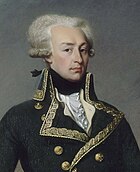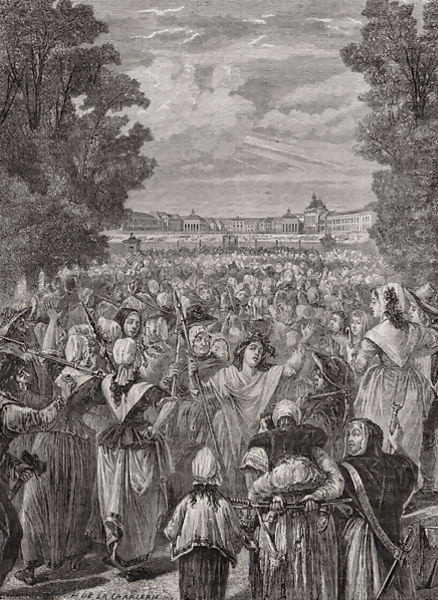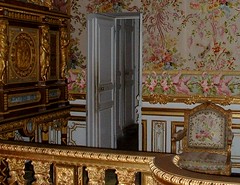Several National Guardsmen who had heard of the march assembled at the Place de Grève where they were met by their commander, the Marquis de Lafayette. But the Marquis soon discovered that the majority of the guardsmen supported the rioters cause and soon began to threat with desertion. Lafayette was commanded to lead the troops - it was better to have reluctant soldiers who still followed command than to face a heavily armed group of soldiers who knew how to fight. Lafayette quickly dispatched a messenger to Versailles with a warning of the awaiting crowd and the advice to the King that he should voluntarily go to Paris to calm down his people. At four o'clock 15.000 armed guardsmen and 7.000 latecomers headed for Versailles led by a nervous Lafayette.
 |
| Marquis de La Fayette |
The President of the Assembly (Jean Joseph Mounier) went to the King's apartments alongside a few of the marketplace women. The King received them and the women were impressed by his charm; an agreement was made that food from the royal stores would be distributed and more would come later on. Maillard and some of the women from the crowd felt that their demands had been met and returned to Paris.
But the majority of the rioters remained. The atmosphere was becoming more and more negative and rumours began circulating that the Queen would use her massive influence (that she did not have in reality) to influence the King. At six o'clock in the evening the King himself appeared and proclaimed that he would accept the Declaration of the Rights of Man and the August degrees. But the palace was not prepared for what was coming next. Most of the royal guards were tired and placed at the far end of Versailles. Only 61 Gardes du Corps remained scattered through the royal palace. Lafayette arrived, hurried to the King and his troops joined the Parisians already located in front of the palace. But the women and troops shared opinions and when dawn broke on October 6 an agreement had been made and the tempers were once again flying high.
At six o'clock in the morning a small group of rioters discovered an unguarded entrance to the palace. The hastily went inside, looking for the Queen's bedchamber. The palace guards ran through the palace while bolting every entrance they could - the guardsmen outside was caught off-guard and fired at the crowd killing a young man. His death caused the rioters to storm the palace, overrunning the outnumbered guards. Miomandre and Tardivet (two guardsmen) were brutally murdered and Tardivet's head was placed on a spike. A guard succeeded in reaching the Queen's chamber where he warned her maid that the rioters were coming for the Queen's head. Marie Antoinette escaped through the secret back-door of her bedchamber and ran barefoot to the King's chamber.
Lafayette managed to calm the main core of the National Guardsmen down and reconcile them with the surviving palace guards - he had always enjoyed a great respect by both and restored order to the palace.
The King was convinced that his appearance would help stabilize the tension among the crowds still occupying the main court. As he stepped out on the balcony cries of "Vive le Roi!" sounded all through the Cour de Marbre. The King - relieved no doubt - proclaimed his intention to travel back to Paris. When the King went inside again the crowd soon demanded "the Queen on the balcony!". Marie Antoinette received a less enthusiastic welcome - she had taken her son and daughter with her but the crowd demanded that they be removed. The hostile crowd - some among them was armed and pointed their weapons at her - was deeply impressed with her dignified appearance as she stood alone on the balcony with her arms serenely crossed over her chest. The atmosphere soon calmed down and Lafayette used the moment to kneel before the Queen and kissed her hand. The rioters even began shouting "Vive la Reine!".
But the King was still to come back to Paris. At one o'clock in the afternoon an enormous cortège escorted the royal family to Paris in their carriage. The crowd had now reached a staggering 60.000 and the journey was nine hours long! There was an almost cheerful atmosphere from the National Guardsmen who carried bread on their bayonets and marketplace women who sang alongside the route. But something darker lurked just beneath the surface. The heads of the guardsmen was carried on spikes and there was an undoubted feeling that the royal family was now prisoners. As the carriage drove towards Paris, Louis XVI and Marie Antoinette must have looked back at Versailles - they would never return and just three years later, they would both be dead.
Illustrations of the Storming of Versailles:
 |
| "The Queen on the balcony!" Lafayette kisses the hand of Marie Antoinette in front of a cheering crowd |
 |
| The royal family during the storm of Versailles: Louis XVI (sitting) issurrounded by his family and in the background four guards try to bolter the door |
 |
| Women's March on Versailles |
 |
| Infuriated women on the Faubourg Saint-Antoine market place in Paris |
 |
| Another depiction of the Women's March - the Versailles Palace can be seen in the background |
 |
| Secret door of Marie Antoinette's bedroom - she escaped through it when the rioters came for "the Austrian's head" |
| Depiction of Marie Antoinette fleeing into her husband arms. The text reads: "Oh dear husband, save me from their rage, in your arms I will fear no outrage." |

No comments:
Post a Comment